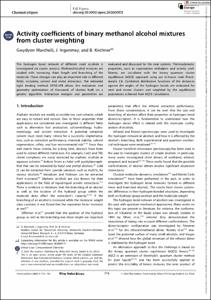Kirchner, Barbara; Ingenmey, Johannes Carl Maria; Marchelli, Gwydyon: Activity coefficients of binary methanol alcohol mixtures from cluster weighting. In: ChemistryOpen. 2020, vol. 9, iss. 7, 774-785.
Online-Ausgabe in bonndoc: https://hdl.handle.net/20.500.11811/10532
Online-Ausgabe in bonndoc: https://hdl.handle.net/20.500.11811/10532
@article{handle:20.500.11811/10532,
author = {{Barbara Kirchner} and {Johannes Carl Maria Ingenmey} and {Gwydyon Marchelli}},
title = {Activity coefficients of binary methanol alcohol mixtures from cluster weighting},
publisher = {John Wiley & Sons},
year = 2020,
month = jul,
journal = {ChemistryOpen},
volume = 2020, vol. 9,
number = iss. 7,
pages = 774--785,
note = {The hydrogen bond network of different small alcohols is investigated via cluster analysis. Methanol/alcohol mixtures are studied with increasing chain length and branching of the molecule. Those changes can play an important role in different fields, including solvent and metal extraction. The extended tight binding method GFN2-xTB allows the evaluation and geometry optimization of thousands of clusters built via a genetic algorithm. Interaction energies and geometries are evaluated and discussed for the neat systems. Thermodynamic properties, such as vaporization enthalpies and activity coefficients, are calculated with the binary quantum cluster equilibrium (bQCE) approach using our in-house code Peacemaker 2.8. Combined distribution functions of the distances against the angles of the hydrogen bonds are evaluated for neat and mixed clusters and weighted by the equilibrium populations achieved from bQCE calculations.},
url = {https://hdl.handle.net/20.500.11811/10532}
}
author = {{Barbara Kirchner} and {Johannes Carl Maria Ingenmey} and {Gwydyon Marchelli}},
title = {Activity coefficients of binary methanol alcohol mixtures from cluster weighting},
publisher = {John Wiley & Sons},
year = 2020,
month = jul,
journal = {ChemistryOpen},
volume = 2020, vol. 9,
number = iss. 7,
pages = 774--785,
note = {The hydrogen bond network of different small alcohols is investigated via cluster analysis. Methanol/alcohol mixtures are studied with increasing chain length and branching of the molecule. Those changes can play an important role in different fields, including solvent and metal extraction. The extended tight binding method GFN2-xTB allows the evaluation and geometry optimization of thousands of clusters built via a genetic algorithm. Interaction energies and geometries are evaluated and discussed for the neat systems. Thermodynamic properties, such as vaporization enthalpies and activity coefficients, are calculated with the binary quantum cluster equilibrium (bQCE) approach using our in-house code Peacemaker 2.8. Combined distribution functions of the distances against the angles of the hydrogen bonds are evaluated for neat and mixed clusters and weighted by the equilibrium populations achieved from bQCE calculations.},
url = {https://hdl.handle.net/20.500.11811/10532}
}






